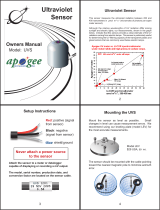Page is loading ...

PAR Sensor(S-PAR-02 / PAR-2.5V)
Features
400~700nm spectral range
High detection accuracy, fast response and good
stability
Output: MODBUS RS485 or 0~2.5V voltage
Small size, simple installation, quick integration
Factory calibration, users do not need to
calibrate again
Wide voltage power supply: 5~24V DC
Applications
Environmental Monitoring
Plant Growth Research
Optical Research
Solar Energy Research
Other Sensor Applications
Introduction
The SenseCAP photosynthetically effective sensor can monitor the photosynthetically effective radiation value in the
environment in real time. It is suitable for crop growth, photosynthetic potential research, tourism environmental
protection ecology, greenhouse control, scientific research institute experiment, solar energy research and other fields,
usually can be connected to various data collectors, data acquisition cards, remote data acquisition modules and other
equipment.
The photosynthetically active radiometer is mainly used to measure the photosynthetically active radiation of
natural light in the wavelength range of 400-700nm. It uses a silicon photodetector and passes through an optical
filter of 400-700nm. When there is light, it produces a radiation that is proportional to the intensity of the incident
radiation. A proportional voltage signal, and its sensitivity is proportional to the cosine of the direct angle of the
incident light. Before leaving the factory, each photosynthetically active radiation sensor will be calibrated. The sensor
directly outputs the measured value in μmol/m2•s. It is simple to use and has a horizontal base for quick installation.
The device can work in an outdoor environment around the clock.
Specifications
Photosynthetically Active Radiation (PAR)
Measurement Range 0 ~ 2500 μmol/m²·s
Resolution 1 μmol/m²·s
Genaral Parameters
Product Model
RS485: S-PAR-02
Voltage: PAR-2.5V
Power Supply
5V ~24V
Output Signal
MODBUS-RTU RS485 or
0 ~ 2.5V Voltage
Measurement Interval
1s
Linearity
Maximum deviation 1%
Drift
<2%/year
Response Time
10 μs
Operating Temperature
-30 ~+ 75 ℃
Operating Humidity
0 ~ 100% (non-condensing)
measurement accuracy
±2%
Cable Length
2 meters
Device Weight
300g
400 ~ 700nm
Spectral Range

Dimensions
Wiring Diagram
RS485 Output:
Voltage Output:
v1.0

PAR Sensor(S-PAR-02 / PAR-2.5V)
Installation
Other Considerations
1. The installation site of the solar photosynthetic active
radiation sensor should be selected without any obstacles
above the plane of the sensing element, ensure that there
are no obstacles with an altitude angle of more than 5 ° in
the sunrise and sunset directions, and avoid shadows
falling on the sensing surface. phenomenon. The watch
should not be near light-colored buildings or other
objects that easily reflect sunlight, nor should it be near
artificial radiation sources.
2. When installing, the sensor should be leveled first
and then fixed.
1. When you receive the product, please check
whether the packaging is intact, and check whether
the sensor model and specifications are consistent with
the product you purchased;
2. The installation place should be kept away from
chemical corrosive environment;
3. Sensors and wires should be far away from high-
voltage electricity, heat sources, etc.;
4. The sensor is a precision device, please do not
disassemble it yourself when using it to avoid damage to
the product;
5. Do not wire with power on, the wire can be turned on
after the wiring is completed, and the inspection is correct;
Modbus-RTU RS485
Standard Modbus-RTU protocol, baud rate: 9600; parity bit: none; data bit: 8; stop bit: 1
For example: Change the address 01 sensor to address 02, and the sensor receives the correct address, then it will return
as it is.
Modify address
Original address
Function code
Data address -H
Data address -L
Data -H
Data -L
CRC16-L
CRC16-H
01
06
01
00
00
02
09
F7
If you forget the address of the sensor, you can use the broadcast command 0 0 to change it to a new address. For
example, if the new address is 03 and the sensor receives the correct address, it will return as it is.
Note: When the broadcast address 00 is used, the master can only connect to one slave at the same time.
Modify address (Broadcast Command)
Command
Function code
Data address -H
Data address -L
Data -H
Data -L
CRC16-L
CRC16-H
00
06
01
00
00
01
48
27
Query the data of the sensor (address 01) (photosynthetic valid), master→slave
Query Data
Address
Function code
address -H
Start address -L
Register length -
H
Register length-L
CRC16-L
CRC16-H
01
03
00
00
00
01
84
0A
If the sensor is received correctly, it will return the following data, slave → master
Address
Function code
Data length
Register 0 data -H
Register 0 data -L
CRC16-L
CRC16-H
01
03
02
04
B3
FB
31
Measurement Value, Unit:μmol/m²·s
Data calculation:
Convert the data to decimal.
As indicated by the above data: 04B3(HEX)=1203 μmol/m²•s
Voltage Output
0~2.5V corresponds to 0~2500 μmol/m²•s
Value = voltage * 1000
For example: if voltage is 1.25V, the value is 1250 μmol/m²•s
v1.0
/

